
Peer Reviewed Chapter
Chapter Name : Augmented Reality Techniques for Image Processing in Interactive Systems and Gaming Applications
Author Name : Rajesh K. Parate, Kishor M. Dhole
Copyright: © 2024 | Pages: 31
DOI: 10.71443/9788197933660-13
Received: 20/05/2024 Accepted: 06/08/2024 Published: 30/10/2024
Abstract
This chapter provides a comprehensive exploration of augmented reality (AR) techniques in image processing, focusing on both marker-based and markerless systems. The increasing demand for immersive user experiences in various domains, including gaming, education, and training, necessitates advanced image processing methods that ensure seamless integration of digital content with real-world environments. Key challenges related to accuracy, precision, and environmental understanding are critically examined, with a particular emphasis on innovative solutions such as depth sensing, simultaneous localization and mapping (SLAM), and machine learning techniques. The chapter also highlights the importance of user interaction design and the aesthetic considerations of markers in enhancing the overall AR experience. By addressing these critical aspects, this work aims to contribute to the development of more robust and user-friendly AR applications, paving the way for future advancements in interactive systems.
Introduction
The rapid evolution of augmented reality (AR) has transformed the way users interact with digital content, merging virtual and real-world environments seamlessly [1]. This technology, characterized by its ability to overlay digital information onto the physical world, has found applications across diverse fields, including gaming, education, healthcare, and industrial training [2]. As users increasingly demand immersive experiences that enrich their understanding and interaction with their surroundings, the importance of advanced image processing techniques in AR cannot be overstated [3,4]. These techniques are pivotal in ensuring that virtual elements are accurately aligned with real-world objects, providing a coherent and engaging user experience [5].
The implementation of image processing in AR systems presents unique challenges, particularly regarding accuracy and precision [6]. Marker-based AR relies on visual markers for tracking, which can be susceptible to various factors, including lighting conditions and environmental complexity [7,8,9]. On the other hand, markerless AR systems employ advanced algorithms, such as simultaneous localization and mapping (SLAM), to interpret the surrounding environment without physical markers [10-12]. While this flexibility enhances usability, it also introduces complexities in accurately mapping virtual content to the physical space [13]. As such, addressing these challenges was essential for developing AR applications that meet the high standards expected by users [14].